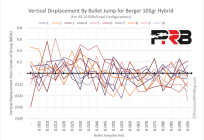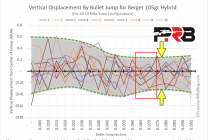I never jumped 105 hybrids more than 20 thau but obviously I was wrong:
...

precisionrifleblog.com
I am going to test the 0.045 jump next week. Have you jumped the 105s so much?
I think you might want to read the article in more detail before setting up a -.045" seating depth test. My understanding from the article is that they were explaining why NOT to use -.045" as a seating depth, suggesting that -.045" is a seating depth that falls in a region where even small amounts of land erosion can quickly cause a significant increase in vertical dispersion.
The initial output of the seating depth test with 105s looked like this:

They followed up with the next figure, using it to illustrate their point (
yellow arrows) regarding how the use of relatively long jumps can be associated with very forgiving (wide) seating depth windows where vertical dispersion has been minimized. To my eye, the portion of the graph to which I added the
red box should be just as good, possibly even better. Regardless, somewhere between -.060" and -.080" is probably the seating depth window you probably want to be testing, not -.045".

An additional bar graph of vertical dispersion versus bullet jump was used to illustrate the same principle. Notice that the region between -.040" and -.050" has the most vertical of the entire test, meaning that it is probably not a good choice for seating depth.

The whole point of this exercise was to find a very forgiving (i.e. wide) seating depth region that produced
good precision, as opposed to a relatively narrow seating depth increment that produced the
best precision. Their reasoning was that a very narrow seating depth optimum that produced the very best precision might also be much more sensitive to changes such as land erosion, etc., and therefore not very forgiving. I would make the argument that we would ideally like to have
both; i.e. a nice wide optimal seating depth window that also produced very good precision.
Part of what that would entail involves the relative rates of land erosion for various cartridges. For example, if someone identifies an optimal seating depth window that is at least two to three x .003" increments wide, how many rounds would a given setup take to shoot erode the lands sufficiently to warrant re-visiting seating depth? For something like a .223 Rem or .308 Win where you might observe something like ~.010" land erosion per 1000 rounds, such a seating depth optimal window might provide as much as 600-900 fired rounds before land erosion would necessitate additional seating depth testing. A rifle setup that exhibited three or four times greater land erosion would require either a much wider seating depth optimal window, or much more frequent seating depth optimization. So basically it's all relative.















